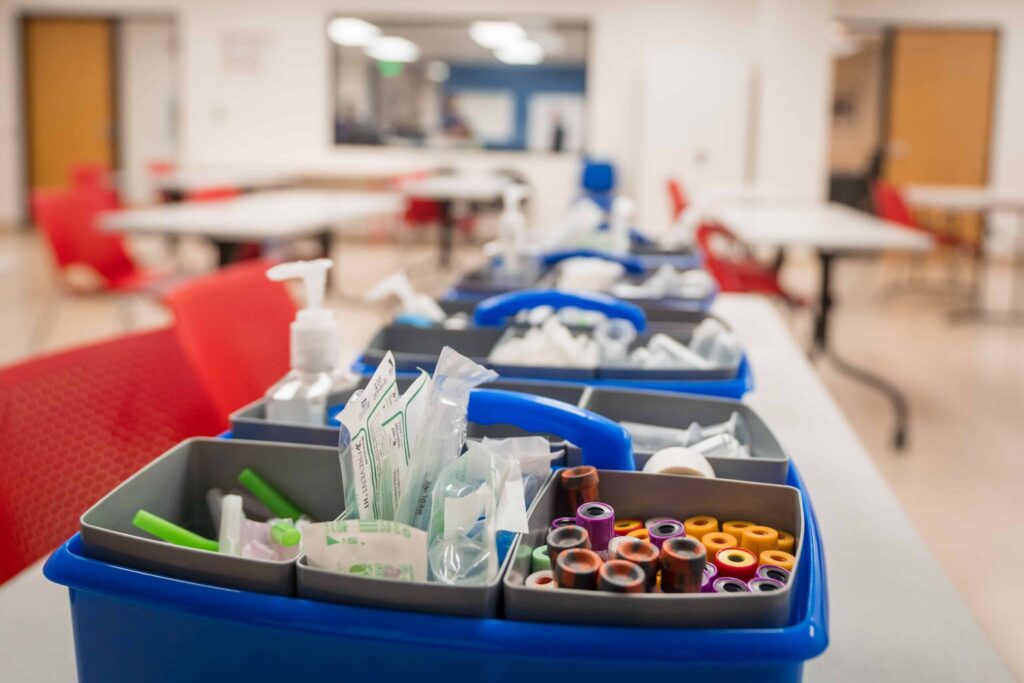Class Calendar | Call admissions on 415-943-2028
Get free phlebotomy training—exclusively for eligible Amazon Associatess / Find MA training at BAMA
Class Calendar | Call admissions on 415-943-2028

California provides three pathways for phlebotomy training and certification, catering to individuals with varying experience levels. In order to obtain a CPT-1 license, which grants the authority to practice phlebotomy in the state, applicants must demonstrate completion of approved training and successfully pass a certification examination. While we will delve deeper into these standards later, here is a general summary of the requirements.
| Entry Level | Mid-Career | Experienced |
No On-the-Job Experience or Less than 40 Hours
| 40-1040 Hours of On-the-Job Experience in the Last 5 Years
| 1040+ Hours of On-the-Job Experience in the Last 5 Years
|
(source)
Someone with no experience practicing phlebotomy will fall into the first category and must attend a California phlebotomy program meeting minimum standards. During that training, they must attend 40 hours of basic and advanced classroom training on phlebotomy.
They will also need to complete clinical hours. During those clinical hours, they will have to perform at least 50 venipunctures and ten skin punctures and observe arterial punctures to meet requirements for testing and licensing. However, for someone with no experience, that small amount of clinical training likely won’t be enough to develop the proper muscle memory needed to be a competent phlebotomist.
Many fly-by-night programs may offer the bare minimum requirements to allow you to apply for your CPT-1, but they won’t necessarily prepare you for the career. Attending a comprehensive phlebotomy program that offers detailed guidance and a clinical externship is the best way to prepare.
In addition, as you’re entering the workforce with no experience, your education will be critical. Attending a reputable, accredited program offering on-the-job experience will make you a more attractive job candidate. That will allow you to explore all the opportunities for phlebotomy career advancement.
Here are some approved entry-level programs to consider:
| Program Length | Cost | |
BAMA Institute | 2 months | $3,522 |
Kaiser Permanente School of Allied Health Sciences | 11 weeks | $4,687 |
Health Career College | 11 weeks | $3,100 |
City College of San Francisco | 1 semester | $46 to $360 per unit |
Contra Costa Medical Career College | 10 weeks | $3,200 |
This is the path that we see individuals use the least because the opportunities for it are few and far between. To qualify for a CPT-1 license under this category, you must meet the same classroom training requirements as someone with no experience; 40 hours of basic and advanced didactic training.
You also have to meet the same standards for clinical hours, but you have to have worked them in an approved position. You can only work as a phlebotomist in California with a CPT-1. That means you can’t take blood without the supervision of a doctor. To qualify under this category, someone will have had at least 40 hours of supervised blood draws. Very few healthcare facilities have the resources to dedicate to that kind of on-the-job training.
It’s typically something we see in small doctors’ offices, where a doctor chooses to train one of their workers on the job and pay for their certification. The opportunities are few and far between, so it’s not a heavily traveled path to phlebotomy training and certification. Available accredited programs would be the same as those available for entry-level trainees.
The final path to phlebotomy certification is an experienced one. In this, the individual will have at least 1,040 phlebotomy hours in the past five years. The most common examples we see here are healthcare professionals who want to expand their skillsets, individuals with foreign medical credentials and those who left and are re-entering the workforce.
In this case, only 20 hours of advanced phlebotomy training is required, and there’s no set amount of clinical time. Candidates will have to show proof of completion of 50 venipunctures and ten skin punctures and observation of arterial punctures.
This is a faster way to get your phlebotomy certification if you have experience, though you will still need to spend some time in the classroom. A phlebotomy refresher course rather than a full program might be the best option. In this, you’re given the opportunity to complete advanced training and refresh your skills with clinical practice without having to do the entire course load.
Here are some options for phlebotomy refresher courses:
| Program Length | Cost | |
BAMA Institute | By assessment | By assessment |
Phlebotomy Training Specialists | 3-5 weeks | $2,595 |
Abrams College | 3 weeks | $3,750 |
PhlebotomyU | Varies | $700 |
While having experience will make you a more attractive employment candidate, it’s important not to overlook the value of an externship. If you’re re-entering the field, this on-the-job training will give you an opportunity to test the waters while you make valuable connections in the healthcare industry.
In California, there are three different paths for phlebotomy training and certification based on experience level. Whether you have no on-the-job experience, mid-career experience, or lots of on-the-job training, you have options. A full phlebotomy course can be your gateway to the industry, while a refresher program will help you update your skills and meet the certification criteria. No matter where you’re at in your phlebotomy journey, there are ways for you to get certified and succeed in this field.
If you’re interested in phlebotomy training and certification in California, BAMA Institute can help. Our reputable, accredited programs are trusted by California’s top healthcare employers. To learn more, contact us.
"*" indicates required fields
© 2024 BAMA Institute. All Rights Reserved. Website by WindsAndWater